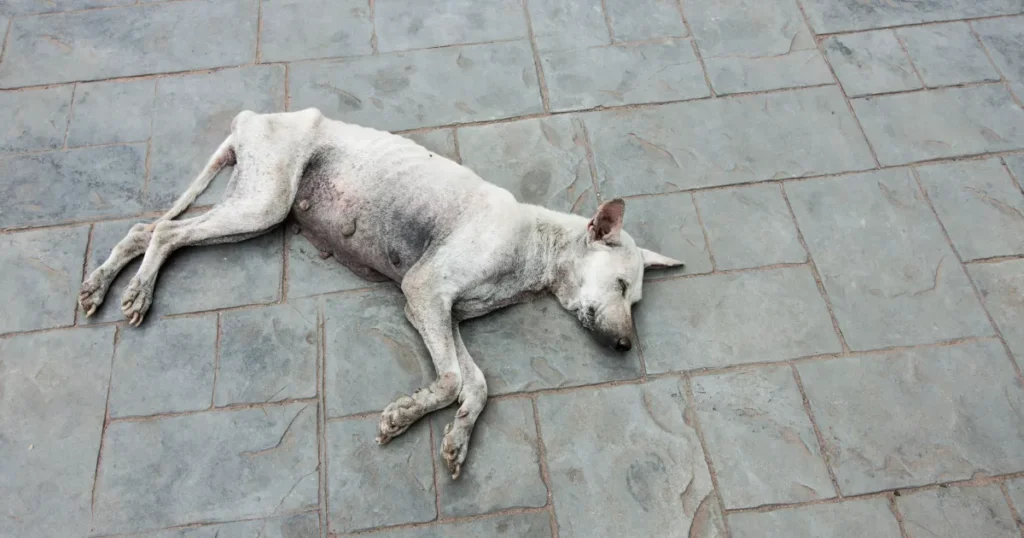Our canine companions are known for their loyalty, energy, and heartwarming affection. Keeping them at a healthy weight ensures they can enjoy a high quality of life. However, like their human counterparts, dogs can face health issues when they’re either overweight or underweight. Here’s a deep dive into these health risks.
Risks for Overweight Dogs

Just as in humans, carrying too much weight can pose severe health risks to dogs. Let’s delve deeper into some of the challenges faced by overweight canines:
1. Musculoskeletal Diseases: Carrying excess weight puts considerable stress on a dog’s frame. This can lead to ruptured ligaments and the painful condition of osteoarthritis, which compromises their mobility and quality of life.
2. Heat and Humidity Tolerance: Overweight dogs find it challenging to cope with high heat and humidity levels. Their excess weight can make them prone to overheating, posing serious health risks during hot weather.
3. Increased Vulnerability to Infections: A compromised immune system, often seen in overweight dogs, means they can be more susceptible to infections.
4. Joint, Mobility, and Skin Problems: The extra weight can strain a dog’s joints, leading to pain and reduced mobility. Overweight dogs might also face skin issues, especially in the folds or areas they can’t groom properly.
5. Surgical Complications: Anesthesia and surgery become riskier for overweight dogs. They might face challenges during recovery or post-surgical complications.
6. Life-threatening Conditions: Obesity isn’t just about the extra pounds; it’s a gateway to serious health conditions. Dogs with obesity can develop diabetes, heart disease, respiratory distress, and even certain types of cancers. These conditions can significantly reduce their lifespan and overall well-being.
Risks for Underweight Dogs

While much attention is paid to the risks of obesity, being underweight poses its challenges for dogs:
1. Compromised Immune System: Dogs that are underweight often have a weakened immune system, making them more susceptible to various infections.
2. Lack of Energy and Muscle Atrophy: Underweight dogs tend to have reduced energy, making them less playful and active. This lack of activity can also lead to a decrease in muscle mass.
3. Risk of Hypoglycemia: An undernourished dog can experience hypoglycemia, where their blood sugar levels drop alarmingly low. This condition can cause weakness, shaking, or even unconsciousness.
4. Anemia: A diet lacking in essential nutrients can result in anemia, a condition characterized by a deficiency of red blood cells. Anemic dogs may appear lethargic and pale.
5. Difficulty in Disease Recovery: An underweight body means the dog has fewer reserves to draw from when fighting off illnesses or recovering from injuries, leading to prolonged healing periods.
Tips for Dog Well-being to Avoid Overweight and Underweight Issues
A balanced approach to your dog’s well-being is crucial to ensure they neither become overweight nor underweight. Here are expert-approved strategies to help your canine companion thrive:
1. Balanced Diet: Feed your dog a balanced diet appropriate for their age, breed, size, and activity level. Premium quality dog foods often provide a comprehensive nutrient profile. If unsure, consult with your veterinarian to determine the best food choice.
2. Regular Exercise: Engage your dog in daily physical activities suitable for their breed and age. Whether it’s a brisk walk, fetch in the park, or agility training, consistent movement helps maintain their weight and muscle tone.
3. Consistent Feeding Schedule: Instead of leaving food out all day, have set meal times. This practice helps monitor intake and prevents overeating.
4. Treats in Moderation: While it’s tempting to shower our pets with treats, they can be calorie-dense. Offer treats sparingly and consider healthier alternatives like carrot sticks or apple slices (ensure there are no seeds).
5. Routine Vet Check-ups: Regular veterinary check-ups can help detect weight-related issues early. Your vet can offer guidance on adjusting your dog’s diet or activity levels if needed.
6. Weight Monitoring: Regularly weigh your dog, or monitor their physique. You should be able to feel but not see their ribs and notice a slight indentation (waist) when viewed from above.
7. Proper Hydration: Always ensure your dog has access to fresh water. Proper hydration supports metabolism and overall health.
8. Avoid Human Foods: Many human foods, especially processed ones, are not suitable for dogs and can lead to weight gain or nutrient imbalances. Additionally, certain human foods can be toxic to dogs, such as chocolates, grapes, and onions.
9. Mental Stimulation: Mental well-being is as vital as physical health. Toys, puzzle feeders, and training sessions can prevent stress eating or loss of appetite due to boredom.
10. Customized Feeding for Health Issues: If your dog has a specific health issue, they may require a specialized diet. For instance, dogs with kidney problems might need a diet low in phosphorus and protein.
In summary, maintaining an optimal weight for your dog is paramount for their well-being. Whether they’re a tiny Chihuahua or a large Golden Retriever, regular vet check-ups, balanced diets, and appropriate exercise are vital components in ensuring they remain hale and hearty. After all, they’re not just pets; they’re family.
Frequently Asked Questions
How can you determine if your dog is at a healthy weight?
A healthy dog should have a discernible waistline when viewed from above. When you touch their sides, you should be able to feel their ribs beneath a thin layer of fat without pressing too hard. If you're unsure, it's always best to consult with your vet, who can provide a more accurate assessment using a body condition score.
What are some effective methods to assist an overweight dog in shedding those extra pounds?
Helping your overweight dog lose weight involves a combination of a balanced diet and regular exercise. Start by consulting your vet about a suitable diet plan, as they can recommend a nutrient-rich dog food with fewer calories. Gradually increasing their physical activity, like daily walks or playtime, can also help. Remember to avoid giving table scraps and consider healthy treats instead.
Can underweight dogs face joint problems too?
Absolutely. While overweight dogs are commonly associated with joint issues due to the extra strain on their skeleton, underweight dogs aren't exempt. Lack of proper nutrition can result in weaker bones and joints, making them susceptible to injuries and arthritis.
Why is it essential to monitor my dog's weight regularly?
Regularly checking your dog's weight ensures they're neither overweight nor underweight, both of which come with health risks. Maintaining an optimal weight can prevent several diseases, enhance mobility, and improve the overall quality of your dog's life.